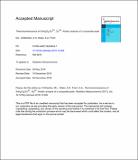Files in this item
Thermoluminescence of SrAl2O4:Eu2+, Dy3+ : kinetic analysis of a composite-peak
Item metadata
| dc.contributor.author | Chithambo, M. L. | |
| dc.contributor.author | Wako, A. H. | |
| dc.contributor.author | Finch, A.A. | |
| dc.date.accessioned | 2017-12-23T00:31:57Z | |
| dc.date.available | 2017-12-23T00:31:57Z | |
| dc.date.issued | 2017-02 | |
| dc.identifier | 248517679 | |
| dc.identifier | 5406896e-b19c-4737-af33-2ca099e4e59c | |
| dc.identifier | 85007060777 | |
| dc.identifier | 000393631600001 | |
| dc.identifier.citation | Chithambo , M L , Wako , A H & Finch , A A 2017 , ' Thermoluminescence of SrAl 2 O 4 :Eu 2+ , Dy 3+ : kinetic analysis of a composite-peak ' , Radiation Measurements , vol. 97 , pp. 1-13 . https://doi.org/10.1016/j.radmeas.2016.12.009 | en |
| dc.identifier.issn | 1350-4487 | |
| dc.identifier.other | RIS: urn:D6095E84F0DA7856CB8824651A01F01A | |
| dc.identifier.other | ORCID: /0000-0002-3689-1517/work/38002308 | |
| dc.identifier.uri | https://hdl.handle.net/10023/12383 | |
| dc.description | The author acknowledges with gratitude financial assistance from Rhodes University and the National Research Foundation of South Africa (Grant UID74438). | en |
| dc.description.abstract | The kinetic analysis of thermoluminescence of beta-irradiated SrAl2O4:Eu2+,Dy3+ is reported. The glow-curve is dominated by an apparently-single peak. It has been demonstrated using a number of tests including partial dynamic-heating, isothermal heating, phosphorescence and, the effect of fading, that the peak and the glow-curve consists of a set of closely-spaced peaks. In view of the peak being complex, its first few components were abstracted and analysed and for comparison, the peak was also analysed assuming it is genuinely single. In the latter, the order of kinetics is calculated to be intermediate between first and second-order and not first-order as predicted by qualitative tests such as the Tm − Tstop or Tm − dose procedures. A model based on density of energy states has been used to account for and reconcile the qualitative and quantitative results. The activation energy is found as ∼1 eV, consistent with the value expected of Dy2+, the presumed electron trapping state of the Dy3+ electron trap. The thermoluminescence is subject to thermal quenching with an activation energy of 0.520 ± 0.002 eV. The luminescence is ascribed to 5d→4f7 Eu2+ transitions whereas the thermal quenching is presumed to occur from an alternative level of the degenerate 5d energy level of the Eu2+ cation. | |
| dc.format.extent | 13 | |
| dc.format.extent | 1597105 | |
| dc.language.iso | eng | |
| dc.relation.ispartof | Radiation Measurements | en |
| dc.subject | Thermoluminescence | en |
| dc.subject | Kinetic-analysis | en |
| dc.subject | SrAl2O4:Eu2+,Dy3+ | en |
| dc.subject | Thermal quenching | en |
| dc.subject | Collocation | en |
| dc.subject | GE Environmental Sciences | en |
| dc.subject | QC Physics | en |
| dc.subject | NDAS | en |
| dc.subject.lcc | GE | en |
| dc.subject.lcc | QC | en |
| dc.title | Thermoluminescence of SrAl2O4:Eu2+, Dy3+ : kinetic analysis of a composite-peak | en |
| dc.type | Journal article | en |
| dc.contributor.sponsor | NERC | en |
| dc.contributor.institution | University of St Andrews. Earth and Environmental Sciences | en |
| dc.contributor.institution | University of St Andrews. Marine Alliance for Science & Technology Scotland | en |
| dc.contributor.institution | University of St Andrews. Scottish Oceans Institute | en |
| dc.contributor.institution | University of St Andrews. St Andrews Isotope Geochemistry | en |
| dc.identifier.doi | 10.1016/j.radmeas.2016.12.009 | |
| dc.description.status | Peer reviewed | en |
| dc.date.embargoedUntil | 2017-12-22 | |
| dc.identifier.grantnumber | NE/H002715/1 | en |
This item appears in the following Collection(s)
Items in the St Andrews Research Repository are protected by copyright, with all rights reserved, unless otherwise indicated.

